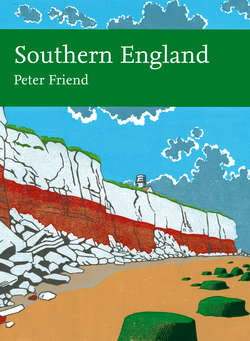Читать книгу Southern England - Peter Friend - Страница 9
MAPPING AND ANALYSING SOUTHERN ENGLAND
ОглавлениеThe detailed discussions of most of the rest of this book have involved dividing Southern England into a number of Areas that form the ‘building blocks’ for the coverage of Southern England (Fig. 3). Each Area is based on a double-page spread of the size used in many of the larger road atlases available for Britain. In this case I have used the Collins Road Atlas, Britain. This means that total coverage of Southern England is provided, and it is easy for the reader to navigate from place to place. At the beginning of each Area description, a location map of the Area and its neighbours is provided. Ordnance Survey (OS) National Grid References are provided for the edges of the Area, in km east and north of the arbitrary OS Grid origin some 80 km west of the Scilly Isles.
FIG 3. Division of Southern England into Regions and Areas.
For convenient reference the Areas – numbered 1 to 16 – are grouped into five Regions. Each Region forms a chapter and starts with a general introduction:
| CHAPTER | REGION | AREA |
|---|---|---|
| Chapter 4 | Southwest | 1 West Cornwall 2 East Cornwall and South Devon 3 North Devon and West Somerset |
| Chapter 5 | South Coast | 4 East Devon, Somerset and Dorset 5 Hampshire and the Isle of Wight 6 Sussex 7 East Sussex and Southeast Kent |
| Chapter 6 | Severn Valley | 8 Bristol 9 The Cotswolds and the Middle Severn |
| Chapter 7 | London and the Thames Valley | 10 The Cotswolds to Reading 11 London 12 The Thames Estuary |
| Chapter 8 | East Anglia | 13 Northampton to Cambridge 14 Suffolk and North Essex 15 Leicester to the Fens 16 Norfolk |
Even the Area building blocks are relatively large, with arbitrary boundaries, and it has generally been helpful to discuss smaller areas within and across these boundaries that are based on natural features of the scenery (Fig. 4). I have called these smaller areas Landscapes, because they are characterised by distinctive features, usually reflecting aspects of the bedrock or distinctive events in their evolution.
These Landscapes correspond closely to area divisions of England that were defined by the Government Countryside Agency (www.countryside.gov.uk). This scheme divides England into 159 ‘character areas’ on the basis of natural features of the scenery along with aspects of its human settlement, past and future development, land use and vegetation and wildlife, so they are likely to be familiar divisions to many readers of the New Naturalist series. Other Government agencies (particularly the Department for Environment, Food and Rural Affairs) that administer the funding of land management use the same character area division.
FIG 4. Examples of the three levels of division adopted in the treatment of Southern England.
Maps displaying patterns of elevation of the countryside above sea level are an important part of the discussions. The elevation data on the maps in this book have been compiled and made available as part of the LANDMAP project, which provides a computer-based digital survey of Britain for research and educational use. LANDMAP Digital Elevation Maps (DEMs) are based on satellite radar survey measurements which divide the land surface into a grid of 25 m by 25 m pixels. The average height of each pixel is then measured to produce a terrain model with a vertical accuracy of about ± 5 m. A standard colour shading scale is used to represent heights, ranging from greens for the lowest ground, through yellows and browns, to greys for the highest ground. It is best to use the full range of colours for each map, no matter what numerical range of heights is involved. This makes it possible to convey the fine detail of slopes etc., whether the map is for the Fens or the high moors. To make it possible to compare between maps using this colour scheme, we have quoted the maximum elevation reached in each Area on each map.
I have used ESRI ARC Geographic Information System (GIS) software in the processing and manipulating of the map data. This software makes it possible to present artificial hill-shading, which makes the topography easier to understand, and to provide maps representing slope patterns in certain areas.
In addition, data on roads, railways, coastlines, town boundaries, rivers, etc. suitable for reproduction at a scale of 1: 200,000 has been made available by the Collins Bartholomew mapping agency. For any further details of the areas covered, it is recommended that Ordnance Survey Landranger (1: 50,000) maps are consulted.
